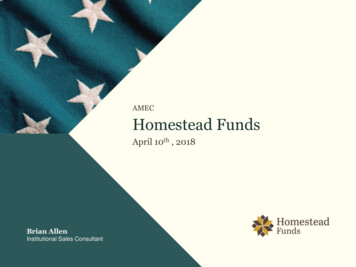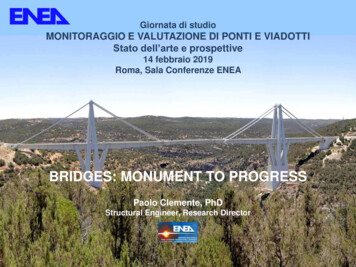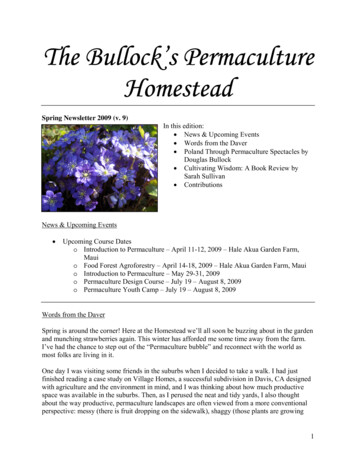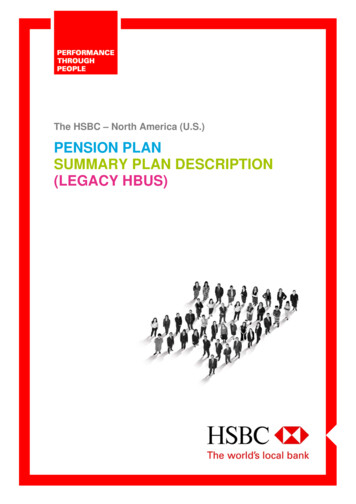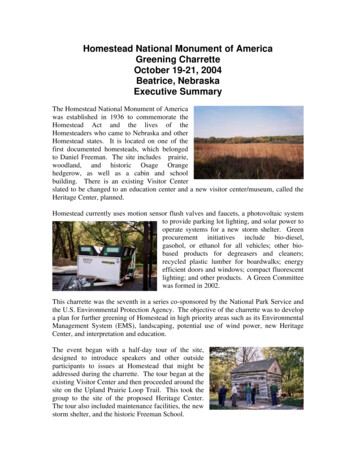
Transcription
Homestead National Monument of AmericaGreening CharretteOctober 19-21, 2004Beatrice, NebraskaExecutive SummaryThe Homestead National Monument of Americawas established in 1936 to commemorate theHomestead Act and the lives of theHomesteaders who came to Nebraska and otherHomestead states. It is located on one of thefirst documented homesteads, which belongedto Daniel Freeman. The site includes prairie,woodland, and historic Osage Orangehedgerow, as well as a cabin and schoolbuilding. There is an existing Visitor Centerslated to be changed to an education center and a new visitor center/museum, called theHeritage Center, planned.Homestead currently uses motion sensor flush valves and faucets, a photovoltaic systemto provide parking lot lighting, and solar power tooperate systems for a new storm shelter. Greenprocurement initiatives include bio-diesel,gasohol, or ethanol for all vehicles; other biobased products for degreasers and cleaners;recycled plastic lumber for boardwalks; energyefficient doors and windows; compact fluorescentlighting; and other products. A Green Committeewas formed in 2002.This charrette was the seventh in a series co-sponsored by the National Park Service andthe U.S. Environmental Protection Agency. The objective of the charrette was to developa plan for further greening of Homestead in high priority areas such as its EnvironmentalManagement System (EMS), landscaping, potential use of wind power, new HeritageCenter, and interpretation and education.The event began with a half-day tour of the site,designed to introduce speakers and other outsideparticipants to issues at Homestead that might beaddressed during the charrette. The tour began at theexisting Visitor Center and then proceeded around thesite on the Upland Prairie Loop Trail. This took thegroup to the site of the proposed Heritage Center.The tour also included maintenance facilities, the newstorm shelter, and the historic Freeman School.
The first full day of the charrette began with awelcome from Mark Engler, Superintendent atHomestead. The first session was a presentationof issues at Homestead and goals for thecharrette by Mark Engler, Laura Stresemann,and Amy Garrett.Next, Gail Lindseyintroduced the sustainability topics that are thefocus of this charrette series: environmentalleadership and planning, ,concessions, interpretation and education, and procurement.To conclude the morning, two guest speakers, Ted Hillmer (Superintendent at Wilson’sCreek National Battlefield) and Chris Case (Facility Manager at Pictured Rocks NationalLakeshore), discussed ideas that could be incorporated into Homestead’s planning for thefuture.After lunch, Kristine Johnson,Supervisory Forester at Great Smoky MountainsNational Park, discussed concepts and resourcesfor sustainable landscape design using nativeplants. Dan McGuire of the American CornGrowers Foundation discussed factors to beconsidered in evaluating wind power systems.Then Gail Lindsey gave an overview of the U.S.Green Building Council’s LEED Rating Systemfor buildings. Finally, Dena Saslaw, GatewayNational Recreation Area, discussed ideas for interpreting sustainability and educatingvisitors and staff.Participants then broke into three workgroups to discuss ideas for (1) planningand EMS, (2) facilities and landscaping,and (3) interpretation and education. Forthe remainder of the day, the groupsdiscussed a vision for their topic and thecurrent status at Homestead to create abaseline. The work groups returned thefinal day to establish short-term, mid-term,and long-term goals and actions; thegroups also identified champions andpartners for high-priority actions as well asbarriers and opportunities and approximate level of cost. At the conclusion of thecharrette, the groups presented their results and Superintendent Mark Engler reacted tothe groups’ priorities.
SUMMARY of Short-Term Goals/Actions and Responsible Champions:Priority Short-Term Goals/ActionsChampionsPlanningApply proposed evaluation process to ideas developed Mark Engler, EMS teamduring charretteFacilities and LandscapeSelect sewage treatment system for Heritage CenterReview Heritage Center design for fire suppression,energy efficiency, LEED credits proposed, energy targetsDevelop cultural resource management plan with IPMDevelop energy and water use baselineInterpretation/ EducationInstall signs describing energy and water saving measuresWork with YCC/schools to provide credit for summerwork (longer term goal)Use Environmental Expo to expand partnerships/ outreachand for messages on reducing dependence on foreign oilInclude messages in Prairie Appreciation event onlandscape and native plantsMark EnglerMarkEngler,LauraStresemannGary Armstrong, LauraStresemann, Jesse Bolli, andMichael StansberryLaura Stresemann, GaryArmstrongAmy GarrettAmy GarrettSusan CookJesse Bolli
Homestead National Monument of AmericaGreening CharretteOctober 19-21, 2004Beatrice, NebraskaFinal ReportBackgroundThe Homestead National Monument ofAmerica was established in 1936 tocommemorate the Homestead Act of 1862and the lives of the Homesteaders who cameto Nebraska and other Homestead states. Itis located on one of the first documentedhomestead, which belonged to DanielFreeman. The site includestall grassprairie, woodland, and historic OsageOrange hedgerow, as well as a cabin andschool building. There is an existing visitorcenter slated to be changed to an education center and a new visitor center planned.Homestead is one of 20 NPS Centers for Environmental Innovation; it beganimplementing innovative technology in the 1980s with water source heat pumps. Sincethen, motion sensor flush valves and faucets, a photovoltaic system for parking lotlighting, and solar power for a new storm shelterhave been installed.Green procurementinitiatives have included bio-diesel, gasohol, orethanol for all vehicles; other bio-based productsfor degreasers and cleaners; recycled plasticlumber for boardwalks; energy efficient doors andwindows; compact fluorescent lighting; and otherproducts. A Green Committee was formed in2002.This charrette was the seventh in a series co-sponsored by the National Park Service andthe U.S. Environmental Protection Agency. The objective of the charrette was to developa plan for further greening of Homestead in high priority areas such as its EnvironmentalManagement System, landscaping, potential use of wind power, new Heritage Center,and interpretation and education.Charrette OverviewThe event began with a half-day tour of the site, designed to introduce speakers and otheroutside participants to issues at Homestead that might be addressed during the charrette.The tour began at the existing Visitor Center and then proceeded around the site on the
Upland Prairie Loop Trail. This took the group to the site ofthe proposed Heritage Center. The tour also includedmaintenance facilities, the new storm shelter, and the historicFreeman School.The first full day of the charrette began with a welcome fromMark Engler, Superintendent at Homestead. The first sessionwas a presentation of issues at Homestead and goals for thecharrette. Mark said that the goal is simple – “to be the bestthat we can be” – but that getting there is more complicated.He acknowledged successes and outlined questions for thecharrette to address. These include how to make the existingVisitor Center greener as it is transformed into an EducationCenter; how to make sure the new Heritage Center is as greenas possible; how to design a sustainable landscape for the new and existing Centers;whether wind power could be feasible, particularly since wind was used by homesteadersas an energy source and fits well with the park’s story; and whether purchasing andrecycling could be improved. Laura Stresemann provided an overview of greenstrategies thathave already beenimplemented, such as recycled materials,water saving fixtures that have saved 15,000gallons of water even with increasedvisitation, bio-based maintenance andcleaning products, solar powered lighting,recycling, and education/ interpretation.She also highlighted a few areas needingattention such as landscaping and nativeplant displays. Amy Garrett discussed someof the park’s interpretation and educationefforts, including the importance to homesteaders of “reducing, reusing, and recycling.”Finally, the park established the following specific goals for the charrette: set goals toimprove on what is already underway, identify realistic ideas and plans for futuredevelopment at the Heritage Center; discuss plans forretrofitting the existing Visitor Center museum space; andidentify potential outreach opportunities to the community andvisitors.Next, Gail Lindsey introduced the sustainability topics that arethe focus of this charrette series: environmental leadership dmaintenance, concessions, interpretation and education, andprocurement.To conclude the morning, two guest speakers discussed ideasthat could be incorporated into Homestead’s planning for thefuture. Ted Hillmer, Superintendent at Wilson’s Creek
National Battlefield, provided examples of “free” resources and very low cost strategies,such as signs above waterless urinals stating how much water is saved per year. ChrisCase, Facility Manager at Pictured Rocks National Lakeshore, also provided specificexamples of strategies that work, including photovoltaics, waste reduction and recycling,product standardization, procurement, reduced toxins, and the bio-based fluidssubstitution program.After lunch, Kristine Johnson, SupervisoryForester at Great Smoky Mountains NationalPark, discussed concepts and resources forsustainable landscape design using nativeplants. Dan McGuire of the American CornGrowers Foundation discussed factors to beconsidered in evaluating wind power systems.Then Gail Lindsey gave an overview of theU.S. Green Building Council’s LEED RatingSystem for buildings. Finally, Dena Saslaw,Gateway National Recreation Area, discussed ideas for interpreting sustainability andeducating visitors and staff.Participants then broke into three work groups to discuss ideas for (1) planning and EMS,(2) facilities and landscaping, and (3)interpretation and education. For the remainderof the day, the groups discussed a vision fortheir topic and the current status at Homesteadto create a baseline. The work groups returnedthe final day to establish short-term, mid-term,and long-term goals and actions; the groups alsoidentified champions and partners for highpriority actions as well as barriers andopportunities and approximate level of cost.At the conclusion of the charrette, the groups presented their results and SuperintendentMark Engler reacted to the groups’ priorities. He said that he had heard lots of goodideas that should be followed up. The highestpriorities, from his perspective, were the sewageand fire suppression systems for the HeritageCenter; getting a baseline on energy use andasking the architects to do energy projections forthe new facility; landscaping for the HeritageCenter with native plants; landscaping for theEducation Center with native plants; interpretivesigns and incorporation of sustainability messagesin new Education Center exhibits; and figuringout what needs to be done now to enable the park to install wind power in the future. Hethanked the group for their work and dedication of time to the charrette.
Highlights of DiscussionPlanning and Environmental LeadershipTeam: Cecil Steward, John Seger, CharlieWhitehead, Ted Hillmer, Chris Case, BobHancock, Dick Fisher, Daris Honemann, RuthHeikkinen, Dugan Smith, David Ha, LauraStresemann, Mark Engler, Joel Ann ToddVision:The group envisioned a process for stimulatingand evaluating new ideas for further greeningof the park and tested it on several ideas.Current Status/ Baseline Conditions EMS Commitment Statement written and process is moving forward GMP (1999) includes sustainability Are discussing standardization and coordination of procurementShort-Term Goals and Actions1. Refine and apply process suggested by group to identify and evaluate proposedactions. The matrix below illustrates the process and factors to be considered inplanning; the group did not suggest that the matrix should actually be filled in butthat it should guide thinking. For each proposed idea:a. Assign to appropriatecategory – planning,transportation, facilities,O & M, interpretation, orprocurement.b. Assess benefits, ) in each of the fivedomains – environment,economics, social aspects, technologies, and policies.Environment retationProcurementSocialTechnologies Policies
2. Consider the following ideas (the group began applying this process to test thefeasibility and usefulness of the process and to provide examples for the park; thegroup was not able to evaluate these ideas fully and further work by the park willbe needed to complete the analysis):a. Make walking the preferable modeof transportation for visitors withinthe site (include interpretation fortrails through audiotape, waysides,interactive kiosks, brochures; loanpedometers to visitors)Environmental ConsiderationsBenefits – reduce airpollution, reduce fossil fuel useDrawbacks/barriers – needto harden paths, more people in the resource (carrying capacity),and possible increase in fire dangerFeasibility –Economic ConsiderationsBenefits – decrease wear and tear on roads, low cost to implementDrawbacks/barriers – increase maintenance of trails, might needmore parking if visitors leave cars in parking lot longerFeasibility – could identify partners to handle overflow parkingSocial/ Cultural ConsiderationsBenefits – health through exercise, enhance visitor experience ofpark, increase learning opportunities, increase interaction withother visitorsDrawbacks/barriers – accessibility, moretime required for visit, safety of thosewalking (particularly in inclementweather) e.g., tripping, heat issues,drinking waterFeasibility – will depend on accessibilityTechnological ConsiderationsLook for hardening material for trailsthat gives “appropriate” appearanceUse solar power for kiosksPolicy ConsiderationsNone identifiedb. Use renewable energy sources in new building and provide interpretation(examples include building-integrated photovoltaic roof system, windgenerator, solar hot water; demonstrations include small pump runningwater powered by small PV cell – visitors can block sun and pump stops)Environmental ConsiderationsBenefits – reduce fossil fuel use, reduce pollution from energyproduction
Drawbacks/barriers – space for array, questions regarding birdstrikes with wind generatorFeasibility –Economic ConsiderationsBenefits – reduce ongoing energy costs(check payback)Drawbacks/barriers – initial cost, spacerequired for battery bank in building,training for staff in maintenanceFeasibility – identify fundingSocial/cultural ConsiderationsBenefits – demonstrate technology tovisitors and perhaps encourage their ownuse of renewables, demonstrate links tohistoric homesteading storyDrawbacks/barriers – view shed impacts of wind generatorFeasibilityTechnological ConsiderationsCheck on availability of sun and wind in specific locationsSelect appropriate size and capacityCheck appropriateness and feasibility of roof systems in existingbuilding designPolicy ConsiderationsWind generator triggers codes/ permits regarding height, proximityto airportc. Conduct charrette processes: one charrette process to program andredesign spaces in existing Visitor Center – bring in students and facultyfrom nearby colleges and universities and second charrette on uses ofEducation Center with community, teachers, museum, Friends group,senior rangers, others; partner with Joslyn Castle Institute for SustainableCommunities and University of NebraskaEnvironmental ConsiderationsBenefits – new ideas ity,relatingenvironmental issues to localneeds, culture, productsDrawbacks/barriers – timingof decisions and academicscheduleFeasibility – participants offered to participateEconomic ConsiderationsBenefits – low cost
Drawbacks/barriers – would require staff time and some outsideassistance to design the charrette and assignmentFeasibility – must very clearly define assignment and parameters/constraintsSocial/cultural ConsiderationsBenefits- excellent eting local needsDrawbacks/barriers –FeasibilityTechnological ConsiderationsNone identifiedPolicy ConsiderationsCheck with academic policies and requirementsd. Right-size the fleet – number of vehicles, size of vehicles, alternative fuelsEnvironmental ConsiderationsBenefits – reduce fossil fuel use, reduce air pollutantsDrawbacks/barriers –Feasibility –Economic ConsiderationsBenefits – fuel savingsDrawbacks/barriers – availability within the GSA fleetFeasibility – depends on GSASocial/cultural ConsiderationsBenefits – demonstrate new technologies (e.g., alternative fuels,smaller vehicles), demonstrates park commitment (signs onvehicles indicate benefit)Drawbacks/barriers – staff preferences for larger vehicles, timerequired to walk, bicycle,drive “golf cart”Feasibility – organize workto require only as muchtravel between buildings asis needed to get work doneandmaintaincommunicationTechnological ConsiderationsCheck into alternativefuels, alternative vehicles –requirements, availability of fueling stations, other feasibilityissuesPolicy Considerationse. Compare homesteaders and present day lifestyles in terms ofenvironmental impact (e.g., environmental footprint)
Environmental ConsiderationsBenefits – visitors recognize their ownenvironmental footprint and try tochange some behavior to reduce it, seethings differently (e.g., organic farming,parkway and travel)Drawbacks/barriers –Feasibility –Economic ConsiderationsBenefits – see self-sufficiency vs.dependence on outside forces, familyfarms vs. agribusiness,Drawbacks/barriers –Feasibility –Social/cultural ConsiderationsBenefits – understand changes in communities, urban interface,migrant farmersDrawbacks/barriers –Feasibility –Technological ConsiderationsDemonstrate evolution of technologies and what this has meant(include safety and health issues)Policy ConsiderationsHow have policies influenced evolution – farm bills, subsidies,imports and exports?3. Consider the following ideas which the group did not assess using the process:a. Minimize purchased energyi. Heritage Center – first reduce energy requirements and thenconsider roof integrated PV, wind, geothermal, capture waste heatfor water heating, solar tube/day lighting, solar hot water, fuel cell;interpret steps takenii. Education Center – first reduce energy requirements (plug loads,envelope, etc.) and then day lighting, solar tube; interpret stepstakenb. Reduce water use – in human systems, mechanical systems, landscapingc. Look for additional opportunities to green procurement – buy localproducts from locally extracted materials if possibleFacilities and LandscapeTeam: Steve Cinnamon, Glen Brinkman, ToddHydo, Larry Kuhl,Dan McGuire, MarkWilloughby, Joyce Coppinger, Sharon Kuska,Kristine Johnson, Laura Stresemann, MarkEngler, Gail Lindsey
LandscapeVision:Landscape for Homestead (existing and new) will be designed, constructed, andmaintained in a long-term sustainable manner to preserve and interpret cultural landscapeand reduce maintenance (mowing, water use, fuel consumption, soil compaction,pollutants and toxins, disturbance producing exotic plants, and reduce herbicide use)Majority of native plants shall be in developed areas; some are not native but are culturalresources and require special placement (e.g., Osage Orange hedgerow)Current Status/ Baseline Conditions Current landscape is high maintenance –non-native plants and turf grass which ismaintained for aesthetics and mowed asneeded, (leaf blowers are also currentlybeing used) Mowings are required tomaintain professional appearance andprovide for safety. A leaf blower is usedto maintain safe and clear walkingsurfaces and control leaves.Short-Term Goals and Actions1.Analyze options and select sewage treatment system for Heritage Center(septic field or lagoon are two initial options to review)a. Obtain information from GWWO architects (Mark)b. Hold a brainstorming meeting in November (Laura, Larry, Mark, Dick,DEQ)c. Check on an existing Site analysis – soil boring information, water usage(to size system), “rest area”, environmental assessment (Region orDenver), and establish solid baseline information on the above2.Create a Cultural Resource Management Plan with Integrated PestManagement components and benchmarks (Gary, Laura, Jesse, Michael)a. Benchmarks (October, November) – water, maintenance, chemicalsb. Plantlist(includeresidence quarters) –Southeast CommunityCollegec. Maintenance – mowing/wooded areas, HeritageCenter, prairie, etc.d. Funding – cost share(PMIS2005Servicewide call), seedstock (local suppliers), Friends group fundraisers, grants (NebraskaArboretum), volunteer labor from colleges, Arbor Day Foundation
3.4.Once the park has established highly sustainable landscaping, the park willreduce mowing and other grounds duties.Partner with Southeast Community College/University of Nebraskahorticulture departments for design of native plant landscape at existingfacility and Heritage CenterLong-Term Goals and Actions1. Remove existing non-native ornamentals (Bugle pine, lilacs.) – must go throughcompliance since it is a designed landscape; donate or sell plants removed throughFriends2. Replace ornamentals with native plants3. Set up a demonstration garden plot to bemaintained by local college horticulturedepartment, volunteers, heirloom plantgroups, Southeast Community College4. Consider options for existing VisitorCenter tree – remove concrete tree well,replace with water-permeable surface5. Develop native plant landscaping list orbrochure for eastern Nebraska inpartnership with NRCS, Southeast Community College, UniversityFacilities Energy and WaterVision:Facilities for Homestead will be designed, constructed, renovated, operated andmaintained to meet high energy efficiency standards so that: (1) LEED criteria are met(benchmarks included), (2) existing facility energy use is reduced, and (3) newconstruction minimizes energy consumption.Current Status/ Baseline Conditions All facilities use electric closed loop geothermal and air toair heat pumps Wood stove in Visitor Center has demonstrated reducedelectric bills and provides interpretive opportunities. No current wind use; partnerships have begun withNebraska Power for future wind use. Park reduces energy use through compact fluorescents,motion sensor lights, heat pumps, and a wood stove Facilities currently use city water for drinking water Old wells are used for watering plants and lawn, firesuppression, and cleaning – (water from the wells are highin nitrates)
Short-Term Goals and Actions1.Review Heritage Center design for fire suppression (curatorial issues, waterneeds) and septic, energy efficiency (lighting, envelope R value, glazing,HVAC system and zones) and all specific LEED credits to be achieveda. Meeting of Mark Engler, Ron Shields, GWWO architects plusconsultants(be specific about energy targets for annual consumption)b. Meeting on heating, cooling, fire suppression with experts and officials –Laura, Todd, Regional Officeengineers2.Establish baseline energy andwater use – Laura, Gary3.Learn about LEED Rating Systemand evaluate use for HeritageCenter and other new construction(The Heritage Center (shell) designwas evaluated against LEEDratings in the spring of 2004 duringthe value analysis phase of theproject))4.Incorporate energy awareness into education programsMid-Term Goals and Actions1.Evaluate generation of power by solar (especially roof tiles as collectors),wind, collection of water – partners include Federal Energy ManagementProgram, Department of Energy, National Renewable Energy Laboratory,Nebraska Power, etc.2.Design Heritage Center with capability to tie into wind as a future optionThe wind goal would be to size the wind generator to meet demand, tie it intothe grid and only pay monthly minimum; this power source must be consistentfor computers. Other concerns and issues with wind: The local power company needs an explanation and to have its concernsaddressed, in regards to what power source will be implemented, how itwill feed back into the grid, and what the effect of the system will be onsite usage and feed back of energy. (KentBullard at Channel Islands is a good resource). NEPA would require public involvement. Maintenance is low but staff must be trained, onthe components of wind generators and solarfeedback into the grid. Historic wind mills were manufactured locally,there is no substation required – 1 or 2 turbinesrun directly into the line that already runs by thepark Surge protectors are required. Partners: the Nebraska Power Review Board andFERC who would need agreement for purchase
3.of surplus (Green Power or Green Tag programs), National RenewableEnergy Laboratory (Jim Green or Larry Flowers) Next steps: create an expert analysis of cost considerations as well asrequirements and benefits (perhaps by NREL), obtain a new Nebraskawind map, and decide exact locations of wind turbine(s)Evaluate low-level lighting options for parking lots as well as needs byseason, placement, controlsInterpretation and EducationTeam: Amy Garrett, Phyllis Howard, Dena SaslawVision:Interpret and educate Homestead greening effortsto visitors in a wide-variety of ways focusedprimarily on the following: (1) Building portation (pull out on Route 4 – fence, life,vegetation), (3) Jr. Ranger Programs/YCC crew(school partners with the park to provide credit for YCC summer crew, youth scouts,kids at risk), (4) Modern “Bees”, (5) Energy and water, (6) Acreage depiction (spatialconcepts, compare/contrast farming practices, walk around building-signs-ethnic), (7)Age related jobs, (8) Clothing (materials, reuse), and (9) social activitiesCurrent Status/ Baseline Conditions Park holds an Environmental Expo during Earth Day Week Park makes in-house signs with educational messages (Alumi-jet) Park has recycling messages and programs Partnershipso Keep Beatrice Beautifulo High School students, Middle School students – water qualityo Soy based productso Senior rangerso FFA/ FBLAo Scouts Park has a Prairie restoration program – gathering seeds, State Historical SocietyFuture Partnerships City – trail, NPPD-energy,schools Extension Service Farm coops Other Federal partners (FederalEnergy Management Program) Microsoft University of Nebraska Lincoln
ToyotaSHPOPBS/NPRSCEPChallenges “We have deep pockets” “We are the Feds” “We don’t need help” Budget realities Staffing issues Resistance to change Social challenges – visitors, students Safety Freeman SchoolOpportunities Better ability to tell our story Better ability to transfer knowledge More interactivities Potential to change perceptions listed above Reduce consumption of foreign oilShort-Term Goals and Actions1.Place signs in bathrooms and other locations where energy efficiency andwater conservation are working – (use sensors for hand washing, recycledcontent towels, etc.)Champion – AmyTiming – 6 monthsSupport – very low cost since the park has an Alumi-Jet sign material and willprint from a computer.Support – no additional cost, only staff time needed2.Work with local schools toprovide credit for YCC crewmwmbers for summer work (i.e.document learning while crew isworking to remove invasiveplants, farming history, potentialharmfulwasteremoval);envourage student to keepjournals and write articles forlocal newspapers. Use theEnvironmental Expo to expandpartnerships and outreach as well as share messages on reducing dependenceon foreign oil (practices and products)Champion – Susan Cook
3.4.5.6.7.Timing – 6 monthsSupport -- partnershipInclude messages in Prairie Appreciation event explaining landscape andnative plant restoration in order toeducate visitors and others regardingpark actions, as well as, reach peoplewho have not visited parkChampion – JesseTiming 1 yearSupport -- PartnershipDevelop visitor Internet count asvisitationChampion – WASO/ Susan CookTiming – 6 monthsSupport –Develop GPS partnership with Garmin to map invasive species anddemonstrate current technology with a “game” approach – (i.e. search forthings in the prairie, answer questions about the ones they find, and mapplacement of signs)Champion – JesseTiming – 6 months – 1 yearSupport – partnersInitiate follow-up email for groups 6 months after they visit, especially forschool groupsChampion – AmyTiming – 6 months – 1 yearSupport –Promote state insect – “Protecting and enhancing the environment will protectand enhance the bees”Champion – JesseTiming – 6 months – 1 yearSupport – PMIS, PACR?Mid-Term Goals and Actions1.Develop linkage with Statue ofLiberty and Galveston to tellimmigrant storyChampion – ToddTiming – 3-5 yearsSupport – Statue/Ellis and parkpartners2.Install educational signage on trailChampion – InterpretationTiming – 3-5 yearsSupport – partners (adopt a sign with Reebok, Nike, Rockport, Trek)
3.Expand use of distance learningChampion – Interpretation/EducationTiming – 3-5 yearsSupport –4.Tell Homestead story with the use ofoutdoor space and art – what aspectsof story need to be told outdoorsChampion – Superintendent, InterpretationTiming – 3-5 yearsSupport –Long-Term Goals and Actions1.Develop international links to tell story of homesteaders rootsChampion – Superintendent/ HistorianTiming – 5-10 yearsSupport –2.Identify and engage Volunteers to become Homestead detectives to doresearchChampion – RV
Management System, landscaping, potential use of wind power, new Heritage Center, and interpretation and education. Charrette Overview The event began with a half-day tour of the site, designed to introduce speakers and other outside participants to issues a
